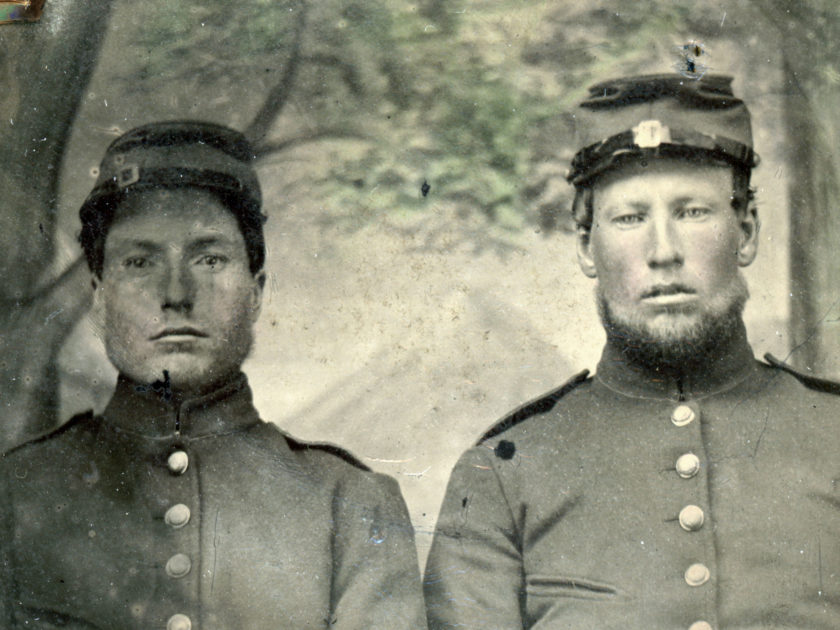By Kurt Luther
The majority of subjects in Civil War photos are anonymous, because, naturally, as most were known to contemporaries, there was little need to record their identities. As these heirlooms passed down to descendants or became separated from families and loved ones, however, the names of those pictured became lost or forgotten.
When we come across these images today, we often have only subtle visual clues, such as the presence of certain uniform styles, insignia or weaponry, to help recover their stories. Occasionally, they offer more explicit hints in the form of some text scratched into the emulsion of a tintype or inked onto the back of a carte de visite. These notes, typically made by family or close friends, can be enigmatic to modern eyes—just enough information to be meaningful to relatives, but frustratingly vague to outsiders. How might a photo sleuth make sense of references to “Uncle William” or “Alonzo with his sister”? And can such inscriptions even be trusted?
In this column, we will investigate the value of photo inscriptions, and in particular family connections, in identifying Civil War soldier portraits. While previous columns have emphasized the value of military records in narrowing down the identities of subjects, here, we will also discuss an example where these sources, per se, prove insufficient.
I recently acquired a sixth-plate tintype of two unidentified soldiers seated beside each other. They wear distinctive jackets with epaulettes, an exterior slit pocket, and a row of eight large buttons. According to Philip Katcher’s State Troops uniform guide, the state of New York issued these jackets in 1861 to the 1st through 105th New York Infantry regiments. This fact would seem to place our mystery men in one of these regiments and early in the war. But, Katcher adds, the jackets were widely admired, and photographic evidence exists of other New York regiments wearing them as late as 1864.

Aside from the New York jackets, the young men offer few other clues to their identities. Their caps lack insignia, and their unadorned sleeves indicate the rank of private. Both are unarmed, their hands folded neatly in their laps. Behind them, a painted backdrop of a bucolic landscape, with trees and a mountain peak, contrasts with the violence these soldiers would likely encounter. The corners of the tintype have been trimmed so that the mat, by Holmes, Booth & Haydens of Connecticut, could be dog-eared over them, and the image lacks a preserver, glass or case.
The back of the tintype offers a promising path forward in the form of a handwritten note on a torn scrap of paper. It reads, tantalizingly, “Grandfather Wilson + his brother in law Lewis Smithers in Civil War uniform.” Although the note isn’t signed, we can assess its reliability through other means. The penmanship and ink quality of the note appear to be post-war. A more obvious clue resides with its language. If the writer is indeed a grandchild of one of these young soldiers, then it is probable that at least 40 years have passed between the creation of the photo and the note, dating the latter to the early 1900s or later. The passage of time provides a valuable lead, but one that we must follow cautiously, as memories fade and witnesses pass from the scene. So the photo sleuth must become a healthy skeptic on the subject of “contemporary” inscriptions.
The only complete name in the note, Lewis Smithers, is the obvious place to start. Conveniently, a search of that name in the American Civil War Research Database, popularly known as HDS, and the National Park Service’s Soldiers and Sailors Database produces just two hits, one on each side of the conflict. We can quickly rule out the Confederate, Pvt. Lewis H. Smithers of Company F, 23rd Virginia Infantry, based upon the visual evidence of the New York state jacket. His Union counterpart, Pvt. Lewis Smithers of Company G, 142nd New York Infantry, has the Empire State affiliation that better fits our theory.
Records show that Smithers enlisted at Oswegatchie, N.Y., in August 1862. Like the subjects in our photo, he was young—just 19 years old. His military career would be tragically brief. Smithers died from diphtheria in a hospital at Upton’s Hill, Va., on Nov. 28, 1862. Ten days earlier, Julia Ward Howe had witnessed a military demonstration on that same hill, inspiring her to write the lyrics for the Battle Hymn of the Republic.
If this Lewis Smithers is pictured in the mystery tintype, then his story may help us identify the other soldier. Smithers’ death dates the photo to this three-month period. The note, referencing his brother-in-law “Grandfather Wilson,” further winnows down the possibilities. We can reason that with some certainty that Smithers had the photo taken with a fellow member of his unit, the 142nd. If a soldier named Wilson served in that regiment between August and November 1862, we may have our man.
In photo sleuthing, the case is never fully closed, and my quest continues to reveal this particular family connection.
Indeed, such a man did exist—several men, in fact. HDS lists eight members of the 142nd with a first or last name of Wilson. One of them, Wilson Husted, enlisted in 1864, two years too late. The other seven Wilsons (all surnamed) enlisted around the same time as Smithers. Horatio Wilson, who mustered in as a 38-year-old sergeant, can also be ruled out. That leaves Charles, Franklin, George, James, John and William Wilson. All six enlisted as privates as young men (aged 18-28) and served until at least 1864. So, which one might be Lewis’s brother-in-law?
We can find the answer in census records. Several online sources provide access to digitized U.S. Federal Census records, but I prefer Ancestry.com because of its powerful search tools and generally accurate transcriptions. Knowing Lewis Smithers’ name, date of death, and enlistment age and location from HDS make it relatively quick work to uncover his records. The 1850 and 1860 censuses reveal that Lewis grew up on a farm in Oswegatchie, with at least six siblings who lived to adulthood. Of these, two sisters were old enough to be married in 1862: Martha, age 24, and Lucy, 22. Martha, who married a man named Adam Ross, can be ruled out. Lucy married as well—to a George Wilson.
This discovery is heartening. The tintype note identifies Lewis Smithers’ brother-in-law as a man named Wilson, and our independent search of census records matches a single individual. Before confirmation bias clouds our judgment, however, let’s first consider how well this George Wilson fits the mold. Returning to the military records, we find that among the six young Wilsons who served in the 142nd at the same time as Smithers, one has the first name George. Better still, this Pvt. George Wilson was among the same 100 men who served with Smithers in Company G.
Wilson outlived his comrade, surviving the carnage that placed the 142nd among the Three Hundred Fighting Regiments as determined by William F. Fox, in his treatise “Regimental Losses in the American Civil War.” Wilson, who suffered a wrist wound at the Battle of Drewry’s Bluff, mustered out with his regiment in June 1865. Two months later, he and Lucy welcomed their first child, who they named Lewis in what appears to be a fitting tribute to their departed brother.
George Wilson’s story completes the circle. The visual clues, the note identifying Lewis Smithers and military records allowed us to narrow down “Wilson” to a handful of likely soldiers. A separate investigation of census records confirmed the existence of Lewis’ brother-in-law, a man named George Wilson, whose biography points to a single individual already present in our shortlist.
An important question remains: which soldier pictured in the tintype is Lewis Smithers, and which is George Wilson? I’ve searched for post-war reference photos of Wilson or physical descriptions of either man, but so far have come up empty. In photo sleuthing, the case is never fully closed, and my quest continues to reveal this particular family connection.
We encourage you to pick up the torch to continue this investigation and, as always, submit other photo mysteries to be investigated as well as summaries of your best success stories to MI via email. Please also check out our Facebook page, Civil War Photo Sleuth, to continue the discussion online.
Kurt Luther is an assistant professor of computer science at Virginia Tech. He writes and speaks about ways that technology can support historical research, education and preservation.

